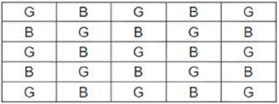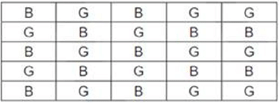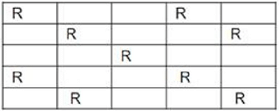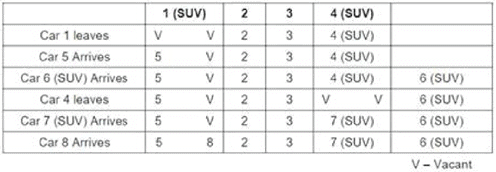Practice Doc: CAT 2020 For LRDI (Slot - 2) | Additional Study Material for CAT PDF Download
Instruction
Twenty five coloured beads are to be arranged in a grid comprising of five rows and five columns. Each cell in the grid must contain exactly one bead. Each bead is coloured either Red, Blue or Green.
While arranging the beads along any of the five rows or along any of the five columns, the rules given below are to be followed:
1. Two adjacent beads along the same row or column are always of different colours.
2. There is at least one Green bead between any two Blue beads along the same row or column.
3. There is at least one Blue and at least one Green bead between any two Red beads along the same row or column.
Every unique, complete arrangement of twenty five beads is called a configuration.
Q.1. The total number of possible configuration using beads of only two colours is:
Ans: 2
Solution: As we need to use only two colours, in any row or column these two coloured beads will be placed alternately like
So we cannot place Red coloured beads at position 1 or two as between any two Red beads there must at least two beads (at least one green and at least one Blue). Hence, we can use only Green and Blue coloured beads.
We can have two possible configurations:
Configuration 1: Green bead is placed at top left corner
Configuration 2: Blue bead is placed at top left corner
Q.2. What is the maximum possible number of Red beads that can appear in any configuration?
Ans: 9
Solution: Between Any two Red beads there must be at least two Beads. So any Row or column there can be maximum two red beads. If we place two red beads in each row then two columns will have three red bead which cannot be accepted.
The above configuration is not correct.
So in the third row we will place only one Red bead at the middle of the third row. Also we will adjust other rows so that between any two Red beads there are at least two beads in any column.
So maximum 9 Red beads are possible in any configuration. At remaining places Green and Blue coloured beads can be placed in such way that all the conditions given are satisfied. There are multiple configurations are possible. One of the configurations is given as below.
Q.3. What is the minimum number of Blue beads in any configuration?
Ans: 6
Solution: To minimise number of Blue beads we need to maximise number of Red and Green beads. From the previous question solution, Maximum no. Red beads can be 9. The row in which has two red beads, we will place two green and one Blue bead additionally.
The row with only one red bead we will place two green and two blue beads additionally. So overall there will be minimum 6 Blue beads.
Q.4. Two Red beads have been placed in ‘second row, third column’ and ‘third row, second column’. How many more Red beads can be placed so as to maximise the number of Red beads used in the configuration?
Ans: 6
Solution: We can place maximum 6 more beads as shown below.
Instruction
A chain of departmental stores has outlets in Delhi, Mumbai, Bengaluru and Kolkata. The sales are categorized by its three departments – ‘Apparel’, ‘Electronics’, and ‘HomeDecor’. An Accountant has been asked to prepare a summary of the 2018 and 2019 sales amounts for an internal report. He has collated partial information and prepared the following table.
The following additional information is known.
1. The sales amounts in the Apparel departments were the same for Delhi and Kolkata in 2018.
2. The sales amounts in the Apparel departments were the same for Mumbai and Bengaluru in 2018. This sales amount matched the sales amount in the Apparel department for Delhi in 2019.
3. The sales amounts in the Home Decor departments were the same for Mumbai and Kolkata in 2018.
4. The sum of the sales amounts of four Electronics departments increased by the same amount as the sum of the sales amounts of four Apparel departments from 2018 to 2019. 5. The total sales amounts of the four Home Decor departments increased by Rs 70 Crores from 2018 to 2019.
6. The sales amounts in the Home Decor departments of Delhi and Bengaluru each increased by Rs 20 Crores from 2018 to 2019.
7. The sales amounts in the Apparel departments of Delhi and Bengaluru each increased by the same amount in 2019 from 2018. The sales amounts in the Apparel departments of Mumbai and Kolkata also each increased by the same amount in 2019 from 2018.
8. The sales amounts in the Apparel departments of Delhi, Kolkata and Bengaluru in 2019 followed an Arithmetic Progression.
Q.5. In Home Decor departments of which cities were the sales amounts the highest in 2018 and 2019, respectively?
(a) Delhi and Delhi
(b) Mumbai and Mumbai
(c) Bengaluru and Delhi
(d) Mumbai and Delhi
Ans: a
Solution:
Home Decor 2018 Highest sales in Delhi
Home Decor 2019 Highest Sales in Delhi
Q.6. What was the increase in sales amount, in Crore Rupees, in the Apparel department of Mumbai from 2018 to 2019?
(a) 12
(b) 5
(c) 10
(d) 8
Ans: a
Solution:
62 - 50 = 12
Q.7. Among all the 12 departments (i.e., the 3 departments in each of the 4 cities), what was the maximum percentage increase in sales amount from 2018 to 2019?
(a) 75
(b) 50
(c) 28
(d) 25
Ans: b
Solution: Maximum percentage increase is form Mumbai HomeDecor from 2018 to 2019 Percentage Increase
Q.8. What was the total sales amount, in Crore Rupees, in 2019 for the chain of departmental stores?
(a) 750
(b) 150
(c) 600
(d) 900
Ans: d
Solution:
Instruction
A shopping mall has a large basement parking lot with parking slots painted in it along a single row. These slots are quite narrow; a compact car can fit in a single slot but an SUV requires two slots. When a car arrives, the parking attendant guides the car to the first available slot from the beginning of the row into which the car can fit.
For our purpose, cars are numbered according to the order in which they arrive at the lot. For example, the first car to arrive is given a number 1, the second a number 2, and so on. This numbering does not indicate whether a car is a compact or an SUV. The configuration of a parking lot is a sequence of the car numbers in each slot. Each single vacant slot is represented by letter V.
For instance, suppose cars numbered 1 through 5 arrive and park, where cars 1, 3 and 5 are compact cars and 2 and 4 are SUVs. At this point, the parking lot would be described by the sequence 1, 2, 3, 4, 5. If cars 2 and 5 now vacate their slots, the parking lot would now be described as 1, V, V, 3, 4. If a compact car (numbered 6) arrives subsequently followed by an SUV (numbered 7), the parking lot would be described by the sequence 1, 6, V, 3, 4, 7.
Answer the following questions INDEPENDENTLY of each other.
Q.9. Initially cars numbered 1, 2, 3, and 4 arrive among which 1 and 4 are SUVs while 2 and 3 are compact cars. Car 1 then leaves, followed by the arrivals of car 5 (a compact car) and car 6 (an SUV). Car 4 then leaves. Then car 7 (an SUV) and car 8 (a compact car) arrive. At this moment, which among the following numbered car is parked next to car 3?
(a) 8
(b) 6
(c) 5
(d) 7
Ans: d
Solution: The parking slots will be numbered as follows.

The cars that are parked next to car 3 are car 2 and car 7.
Q.10. Suppose eight cars have arrived, of which two have left. Also suppose that car 4 is a compact and car 7 is an SUV. Which of the following is a POSSIBLE current configuration of the parking lot?
(a) V, 2, 3, 7, 5, 6, 8
(b) 8, 2, 3, V, 5, 6, 7
(c) 8, 2, 3, V, 6, 5, 7
(d) 8, 2, 3, V, 5, 7, 6
Ans: b
Solution: When cars 5 and 6 are present, car 7 cannot take a place between them. So , 5,7,6 is not possible.
8, 2, 3, V, 5, 6, 7 is possible in the following sequence of arrival of cars.
I. Cars 1,2,3,4,5,6 and 7 arrive one after the other.
II. Car 1 leaves
III. Car 8 arrives and is parked in the slot vacated by car 1
IV. Car 4 leaves.
V. 2,3,7,5,6,8 is not possible as car 7 (SUV) cannot be parked in place of car 4 (compact) while cars 3 and 5 are still parked. 8, 2, 3, V, 6,5,7 is not possible as car 6 cannot be between a vacant slot and to the left of car 5 for the following reasons.
If no slot is vacant when car 6 is arrived, it would have been parked to the right of car 5.
If car 4 (compact) left by the time car 6 arrives it would either be parked in the slot vacated by car 4 or to the right of car 5.
Q.11. Suppose the sequence at some point of time is 4, 5, 6, V, 3. Which of the following is NOT necessarily true?
(a) Car 5 is a compact.
(b) Car 4 is a compact.
(c) Car 3 is an SUV.
(d) Car 1 is an SUV.
Ans: c
Solution: From the given arrangement it can be understood that cars 1, 2 and 3 arrived first and then cars 1 and 2 left before cars 4, 5 and 6 arrived. Now, there are four slots to the left of car 3. Hence, cars 1 and 2 are SUVs. Since three out of four slots are occupied by cars 4, 5 and 6, all these are compact cars. Whether car 3 is a compact car or an SUV, the given arrangement is possible.
Q.12. Suppose that car 4 is not the first car to leave and that the sequence at a time between the arrival of the car 7 and car 8 is V, 7, 3, 6, 5. Then which of the following statements MUST be false?
(a) Car 7 is a compact.
(b) Car 4 is an SUV.
(c) Car 6 is a compact.
(d) Car 2 is a compact.
Ans: c
Solution: As cars 3 and 5 are still in their positions and that car 4 is not the first car to leave, at least one of cars 1 and 2 left before car 4. Let us consider the following cases. Both cars 1 and 2 left before car 4: In this case car 6, whether it is a compact car or an SUV, would have been parked in the parking lots vacated by cars 1 and 2. Hence, this case is not possible.
Only car 1 left before car 4: As car 6 is parked in the lot vacated by car 4, car 7 would have been parked in place of car 1. But the s lot vacated by car 1 is still vacant. Hence, this case is not possible.
Only 2 left before car 4: If the car 2 is an SUV, car 6 would have been parked in that lot. Hence, cars 2 and 7 are compact cars. Car 1 left after car 7 arrived.
Instruction
The Humanities department of a college is planning to organize eight seminars, one for each of the eight doctoral students - A, B, C, D, E, F, G and H. Four of them are from Economics, three from Sociology and one from Anthropology department. Each student is guided by one among P, Q, R, S and T. Two students are guided by each of P, R and T, while one student is guided by each of Q and S. Each student is guided by a guide belonging to their department.
Each seminar is to be scheduled in one of four consecutive 30-minute slots starting at 9:00 am, 9:30 am, 10:00 am and 10:30 am on the same day. More than one seminars can be scheduled in a slot, provided the guide is free. Only three rooms are available and hence at the most three seminars can be scheduled in a slot. Students who are guided by the same guide must be scheduled in consecutive slots.
The following additional facts are also known.
1. Seminars by students from Economics are scheduled in each of the four slots.
2. A’s is the only seminar that is scheduled at 10:00 am. A is guided by R.
3. F is an Anthropology student whose seminar is scheduled at 10:30 am.
4. The seminar of a Sociology student is scheduled at 9:00 am.
5. B and G are both Sociology students, whose seminars are scheduled in the same slot. The seminar of an Economics student, who is guided by T, is also scheduled in the same slot.
6. P, who is guiding both B and C, has students scheduled in the first two slots.
7. A and G are scheduled in two consecutive slots.
Q.13. Which one of the following statements is true?
(a) Three seminars are scheduled in the last slot.
(b) Only one seminar is scheduled in the second slot.
(c) Two seminars are scheduled in the first slot.
(d) Three seminars are scheduled in the first slot.
Ans: c
Solution: From the above table, it is clear that the statement that two seminars are scheduled in the first slot is true
Q.14. Who all are NOT guiding any Economics students?
(a) P, R and S
(b) P, Q and R
(c) P, Q and S
(d) Q, R and S
Ans: c
Solution: We know that R is guiding an economics student. Hence, choices with R can be are eliminated. None among P, Q and S is guiding an economics student.
Q.15. Which of the following statements is necessarily true?
(a) S is guiding F.
(b) Q is guiding G.
(c) B is scheduled in the first slot.
(d) H is an Economics student.
Ans: d
Solution: B is scheduled in the second slot. W e are not sure of who are guiding G and F. So, two other choice s are not necessarily true.
Q.16. If D is scheduled in a slot later than Q's, then which of the following two statement(s) is(are) true?
(i) E and H are guided by T.
(ii) G is guided by Q.
(a) Only (ii)
(b) Neither (i) nor (ii)
(c) Both (i) and (ii)
(d) Only
Ans: c
Solution: D‘s seminar is scheduled later than Q’s seminar, indicates that Q’s seminar cannot be in the last slot. It implies F is guided by S and G by Q. Hence, statement (ii) is true. Now that Q’s seminar is scheduled in the second slot, D’s seminar is scheduled in the lost slot. i.e D is guided by R. Hence, E and H are guided by T. Thus, statement (i ) is also true. Both (i) and (ii) are true.
Q.17. If E and Q are both scheduled in the same slot, then which of the following statements BEST describes the relationship between D, H, and T?
(a) Both D and H are guided by T.
(b) At least one of D and H is guided by T.
(c) Exactly one of D and H is guided by T.
(d) Neither D nor H is guided by T.
Ans: b
Solution: If E and Q are scheduled in the same slot, it is possible both in the second slot and the last slot. If it is in the second slot, then E is guided by T and one among D and E is also guided by T. If it is in the last slot, then E is guided by R and both D and E are guided by T. Thus, at least one of D and H is guided by T.
Q.18. If D is scheduled in the slot immediately before Q’s, then which of the following is NOT necessarily true?
(a) G is guided by Q.
(b) E is guided by R.
(c) D is guided by T.
(d) F is guided by S.
Ans: b
Solution: If D is scheduled in the slot immediately before Q’s, it is only possible with D is in the first slot and Q is in the second slot. It implies that D is guided by T, G is guided by Q and F is guided by S. One among E and H is guided by T and the other one b y R, in any order. Hence the statement that E is guided by R is NOT necessarily true.
Instruction
In an election several candidates contested for a constituency. In any constituency, the winning candidate was the one who polled the highest number of votes, the first runner up was the one who polled the second highest number of votes, the second runner up was the one who polled the third highest number of votes, and so on. There were no ties (in terms of number of votes polled by the candidates) in any of the constituencies in this election.
In an electoral system, a security deposit is the sum of money that a candidate is required to pay to the election commission before he or she is permitted to contest. Only the defeated candidates (i.e., one who is not the winning candidate) who fail to secure more than one sixth of the valid votes polled in the constituency, lose their security deposits.
The following table provides some incomplete information about votes polled in four constituencies: A, B, C and D, in this election. 
The following additional facts are known:
1. The first runner up polled 10,000 more votes than the second runner up in constituency A.
2. None of the candidates who contested in constituency C lost their security deposit. The difference in votes polled by any pair of candidates in this constituency was at least 10,000.
3. The winning candidate in constituency D polled 5% of valid votes more than that of the first runner up. All the candidates who lost their security deposits while contesting for this constituency, put together, polled 35% of the valid votes.
Q.19. What is the percentage of votes polled in total by all the candidates who lost their security deposits while contesting for constituency A?
Ans: 9
Solution: Total valid votes in A = 5,00,000 Minimum no of valid votes required to save the security deposits = 1/6 x 5,00,000 = 83,334
As per 1st additional information ⇒ the gap between 1st and 2nd runners up is 10,000 So the table for A ⇒ total → 5,00,000
Winner → 2,75,000
1st runner up → 55,000
2nd runner up → 85,000
Total → 4,55,000
The valid votes got by the other 7 candidates = 5,00,000 - 4,55,000
= 45,000
∴ the % of votes by the candidates who lost the security deposit is 45,000/5,00,000 x 100 = 9%
Q.20. How many candidates who contested in constituency B lost their security deposit?
Ans: 11
Solution: Total valid votes in A=3,25,000
Minimum no of valid votes required to save the security deposits = 1/6 x 3,25,000 = 54,167
We can see the winner himself/herself has got 48,750 no of votes which is less than 1/6 th of the total votes.
∴ all of the candidates got less than 1/6 th of the valid votes.
∴ security deposits will be forfeited for all of the candidates as winner is exempted from this condition. (total no of such candidates = 12 - 1 = 11)
Q.21. What BEST can be concluded about the number of votes polled by the winning candidate in constituency C?
(a) 1,40,006
(b) less than 2,00,010
(c) 1,40,010
(d) between 1,40,005 and 1,40,010
Ans: a
Solution: As the additional information in condition (2)
The minimum difference in no of votes between any pair of candidates = 10,000 As there are 5 candidates in c, the possible distribution of valid is as follows.
Additional 30 votes can be distributed among them to maintain the gap at least 10,000. So the possible answer is 1,40,006
Q.22. What was the number of valid votes polled in constituency D?
(a) 1,75,000
(b) 1,50,000
(c) 1,25,000
(d) 62,500
Ans: a
Solution: Let the no of valid votes = 100 x
The table looks like the following:
Total votes → 100x
Winner → 39,375
1st → 37,500
2nd → 30,000
3rd → 10x
Total → 1,06,875
As the winner got 51 more than 1st runner up (as per 3)
Total no of votes has to be more than
=1,10,208
∴ option (62,500) is ruled out.
To eliminate two more options, lets consider 1,50,000 to be the correct one [as one option is less than \& the other one is the greater than this option]
∴ 100 x = 1,50,000
Total → 1,50,000
Winner → 45,000
1st → 37,500
2nd → 30,000
3rd → 15,000
Total → 1,06,875
Minimum rates to save security deposits = 1/6 x 1,50,000 = 25,000
So we can see except 3 candidates all others have lost their security deposits.
Candidates who saved their security deposits = (100 - 35)% = 65% [as per 3rd additional inform]
∴ 65% of 1,50,000 = 97,500
→ which is less than 1,12,500
∴ answer will be more than 1,50,000
Q.23. The winning margin of a constituency is defined as the difference of votes polled by the winner and that of the first runner up. Which of the following CANNOT be the list of constituencies, in increasing order of winning margin?
(a) B, D, C, A
(b) D, B, C, A
(c) B, C, D, A
(d) D, C, B, A
Ans: c
Solution: Margins
A → 2,75,000 - 95,000 = 1,80,000
B→
C → 1,50,000 - 1,40,000 = 10,000
D → 39,375 - 37,500 = 1,875
Clearly the margin in C is more than that of D. So clearly the sequence B, C, D, A is not possible.
Q.24. For all the four constituencies taken together, what was the approximate number of votes polled by all the candidates who lost their security deposit expressed as a percentage of the total valid votes from these four constituencies?
(a) 23.91%
(b) 23.54%
(c) 32.00%
(d) 38.25%
Ans: a
Solution: The no. of votes got by the candidates who has lost their security deposits is as follows
In A → 45, 000
In B → 3,25,000 - 48,750 = 2,76,250
In C → 0
In D → 1,75,000 - 46,250 - 37,500 - 30,000 = 61250
|
5 videos|385 docs|204 tests
|















